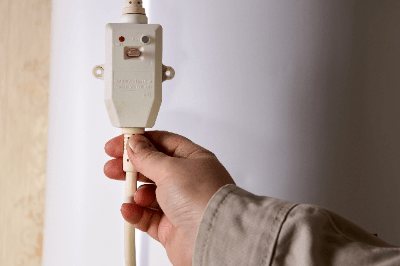What Is an Earth-Leakage Circuit Breaker?

An earth-leakage circuit breaker (ELCB) is an electrical safety device used to protect people from electrical leakage.
By connecting an earth-leakage circuit breaker plug to an electrical outlet, it is possible to prevent personal injury caused by electrical leakage from electrical equipment and appliances. In some household distribution boards, breakers without a leakage current function are used.
If leakage current occurs from electrical equipment or appliances, there is a risk of personal injury. Using an earth-leakage circuit breaker to connect to the equipment can prevent these accidents. In addition, electrical leakage can cause fires. An earth-leakage circuit breaker can also reduce the risk of fire because it detects leakage and shuts off the power supply.
However, when using an earth-leakage circuit breaker, it is important to verify proper specifications and standards. Incorrect selection may result in a risk of incorrect functioning.
Uses of Earth-Leakage Circuit Breakers
Earth-leakage circuit breakers are used in a variety of applications. In general, they are often used for household appliances.
1. General Household
Earth-leakage circuit breakers are used for electrical appliances and home electronics used in the home. Refrigerators, washing machines, and microwave ovens are typical examples. They reduce the risk of electric shock and fire due to electrical leakage and improve home safety.
2. Offices and Commercial Facilities
In offices and commercial facilities, earth-leakage circuit breakers are often connected to printers, telephones, and other office automation equipment. This prevents electrical shock accidents and ensures a safe working environment.
3. Construction Sites
Electric tools are frequently used on construction sites. These tools require high power and may cause electrical leakage. By using an earth-leakage circuit breaker, the power supply of the tools can be protected and the workers can be protected from electric shock.
Principle of Earth-Leakage Circuit Breakers
The principle of an earth-leakage circuit breaker is to detect a leakage and cut off the power supply. A leakage current detector is often incorporated to detect leakage current. The leakage current detector uses a sensor that detects differences in the current.
The RCD compares the current from the power supply to the equipment with the current from the equipment to the power supply. Normally, these two currents should flow the same amount, but when a leakage current occurs, a leakage current is generated. This difference is detected by the leakage current detector.
The leakage current is detected when the difference in current exceeds a certain set value. The set value is generally a few mA to a hundred mA. This set value is appropriately set based on the risk of electric shock or fire.
When an earth-leakage circuit breaker is detected, the shutdown mechanism in the earth-leakage circuit breaker is activated and the power supply is immediately disconnected. This will stop the power supply to the circuit or device where the leakage has occurred, reducing the risk of electric shock or fire.
How to Choose an Earth-Leakage Circuit Breaker
When selecting an earth-leakage circuit breaker, the following factors should be considered:
1. Protective Function
The main purpose of an earth-leakage circuit breaker is to detect leakage and shut off the power supply. However, earth-leakage circuit breakers with overcurrent protection are also available. The presence or absence of an overcurrent protection function should be considered when purchasing a plug.
2. Number of Poles
The number of poles in an earth-leakage circuit breaker refers to the number of pins in the plug. Generally, it is 2 or 3 poles. In order to select the proper number of poles, it must match the requirements of the electrical equipment or appliance being used and the number of poles in the outlet to which it is connected.
3. Voltage Rating
The voltage rating of an earth-leakage circuit breaker indicates the voltage range of the power supply suitable for normal operation. It should be matched to the appropriate voltage range for the electrical equipment and appliances used. For general household use, the voltage is 100V or 200V, with 100V being the most common.
4. Current Rating
The current rating of an earth-leakage circuit breaker plug is the maximum current that the plug can handle. It is important to select a plug with a current rating higher than the total current consumption of the electrical equipment used. Failure to select an appropriate current rating may result in burnout or other failures.
5. Current Sensitivity
The sensitivity current of an earth-leakage circuit breaker is the set value of sensitivity for detecting leakage current. Most common earth-leakage circuit breaker products have a sensitivity current of several mA to 20 mA. Since the ground fault current at the time of an accident varies depending on the situation, it is safer to use a product with a smaller sensitivity current.
Some earth-leakage circuit breakers may be classified into high-sensitivity, intermediate-degree, and low-sensitivity types.